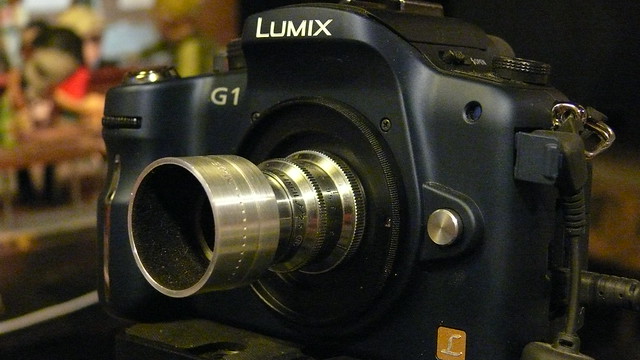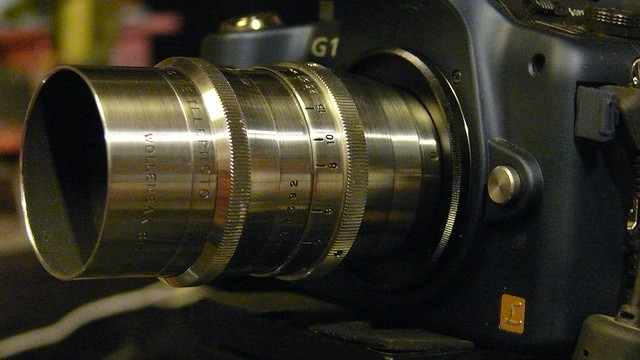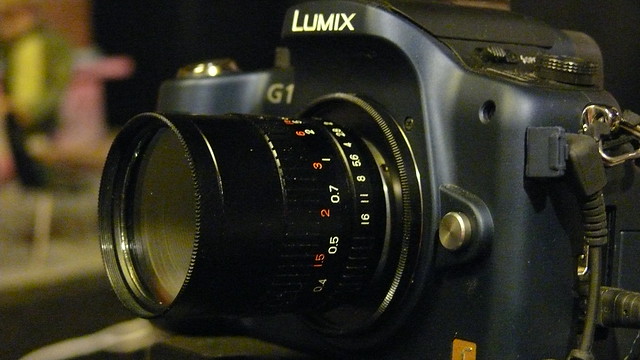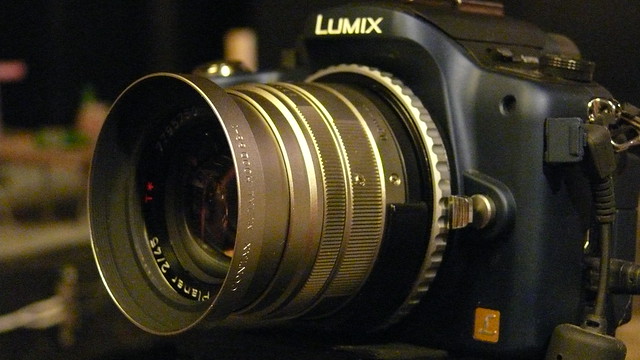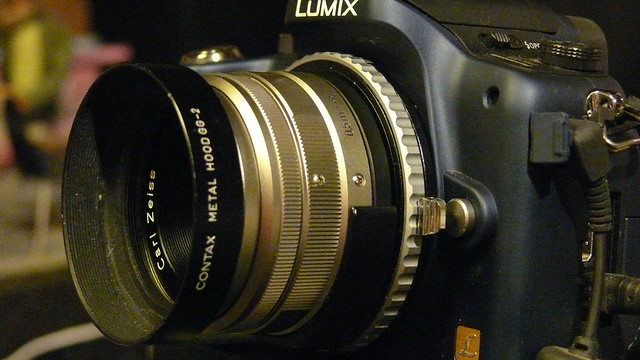 |
| Clear plastic tub-o-lenses |
Lens Rankings:
- I love my CCTV lenses - the little black plastic ones you see grouped together in the pic at the top. They always have TV in the name. Made by companies like Fujinon, Elbex, Pentax, Cosmicar and many more in the 90's on up. I consider these probably the best kind of lens to use for what I'm doing - at least of the lenses I've tried. These lenses have given me no trouble at all (aside from the fact that the really wide ones require cropping in post).
- Next comes my Nikon SLR lens. I like that one just as much I think. Beyond that my lenses begin to become a bit problematic.
- The 2 (silver plastic on the far right) Carl Zeiss Contax G lenses are nearly as trouble-free as the black ones - and they're excellent quality glass - but focusing is a bit difficult (the only problem with them, and only a small one if you have the good adapters - more info below).
- Then the old hefty machined metal lenses (on the far left) made for 16mm movie cameras are too heavy and have poor optical coatings - causing lens flare and color fringing problems, and since they're old many of them can have problems like tight focusing or oil on the iris blades etc.
Looking back I can't believe how much time and effort (and money) I've put into acquiring lenses for my G1. Several long posts dedicated to nothing else - lots of money spent on modifications (that really were unnecessary - keep reading). In the beginning I knew basically nothing - every step of the way was a learning experience, and now I've got a good deal of knowledge racked up and it seems like a great time to stop and get down my thoughts and findings before my sieve-like memory betrays me. It might be helpful to someone else wanting to use a Micro Four Thirds camera for stopmotion. So without further ado, my thoughts and findings:
I find I'm not using the metal-barrelled cine camera lenses - the ones made for 16mm movie cameras. I love the look of them - the solid heft of machined and polished steel - the engraved markings. Exotic and beautiful - relics from a time when things were made differently. But they're heavy on the camera, making it more difficult to hang it under the Manfrotto arm and swing it around over the set, plus they don't have the more advanced optical coatings that later lenses do, which reduce or eliminate lens flare and chromatic aberration. They do give a more 70's type look (well, 70's and all decades previous) that I thought I would like, since I love 70's movies with all their flaws. But I find I'm using mostly the TV lenses (which are made for closed-circuit TV and security camera use) like the Fujinon-TV 12.5mm and 25mm and the Elbex-TV 8mm. Another lens I use is the Micro-Nikkor-P 55mm. Followed by the Carl Zeiss Contax G series lenses - 35mm and 45mm - which are excellent, but a bit difficult to focus, even though I now have better adapters that make it much easier and more precise than the older adapters. The adapters I bought originally* (see note below in green) used a tiny knurled thumbwheel for focus. It's location - jammed right up against the body of the camera and too close to the base - meant that I had to try to wedge my thumb in between the bottom of the lens and the tripod platform, or else try to use my thumbnail to turn the wheel, and when I did get the wheel to turn it didn't always engage with the lens' focusing mechanism - a very hit and miss procedure and extremely frustrating (I definitely wouldn't use these adapters for focus pulls).
But the ones I bought from Hong Kong on eBay have a large focus ring all the way around the circumference of the lens base - no slippage and no frustration. Well, slightly frustrating at times just because it's a thin ring and it's still jammed up right against the body of the camera, but that's much better than the older adapters - trust me! Though to be honest if I was going to pull focus on a shot I'd lean toward one of my other lenses that have a focus ring right on the lens barrel itself rather than on the adapter.
* Important note - the Amazon page actually shows the picture of the newer and better adapter and the price is ridiculous at $60.00 - but when you order, what you actually receive is the older adapter with the little frustrating knurled thumbwheel for focus. DO NOT order this item from Amazon - instead order from Holga Camera - it's much less expensive and you'll get the newer/better adapter that uses a full focusing ring.
Contax G lens to Micro Four Thirds adapters - the good and the bad
Here are 2 YouTube videos I hunted up just to demonstrate how both the older style adapters with the thumbwheels and the newer ones with full focusing rings work. First up - old thumbwheel style (BAAAD Adapter!):
And the newer style (Gooood Adapter!):
Crop Circles
 |
| what you get directly from the camera |
 |
| .. and after cropping and a little color adjustment - it's still slightly larger than HD! |
.. And still get HD sized images, then there's no need for full lens coverage. I mean it is a nice thing to have - it makes framing your shots simple - what you see is exactly what you get. But cropping isn't difficult at all. This is an issue that only affects the wide lenses - the wider you go the less coverage you get on the m43 sensor. So for those wide lenses, feel free to buy an unmodified Fujinon-TV 12.5mm and 25mm - and just crop away the edges. Same for the Elbex-TV 8.5mm or similar ultrawide lenses, even if they're made for a 1/2" format camera (as opposed to the 1" format, which is approximately the same size as the m43 sensor).
There's also no need to get a zoom lens, as I briefly mentioned in my last lens post. Just as cropping makes expensive lens modifications unnecessary, digital zooming makes a zoom lens unnecessary. It looks exactly the same whether it's done by twisting the barrel of a zoom lens or in software during post processing.
Keep in mind, I'm using my camera strictly for stopmotion animation, so I have certain advantages over anyone using theirs to capture live action video. Namely, I shoot still pictures that are much larger than any video image (they're more than twice the size of 1080p) so I can crop pretty far and still pull HD images with absolutely no loss of quality. I imagine for zooming in live action video you'd want to use an actual zoom lens that gives full coverage because you wouldn't be able to crop much in post without degrading image quality, since you're starting with images only captured at HD resolution. In fact if you're shooting live video you'd also want your wide angle lenses to have full coverage for the same reason - you won't be able to crop without losing resolution. So forgive me for saying it but - nanny nanny boo boo!! This is one area where stop motion animators have a distinct advantage over live action videographers. Hah! Take that!!
In an upcoming post I'll do for my micro 4/3s camera what I did in this one for lenses - I'll look back and sum up the key points - the strengths and weaknesses in using them for stopmotion.
Last minute Addendum:
Oops! 2 more freebies!! - and a little more home-studio lens surgery (total success this time)
 |
| 2 old Pentax-TV lenses I've had sitting around for years - now back in service again! |
Here are 2 more freebie lenses - these are also ones I was using with my Hitachi analog broadcast camera about 8 years ago (like the Rainbow zoom lens I mentioned a couple of posts back). Had to search a lot harder for these, but they finally turned up, in absolutely new condition because I kept them wrapped in bubble wrap and packed in their boxes. One is a 12mm f1.2, the other a 6mm f1.2. The 6mm - the larger of the two above, required a little surgery before it would fit snugly into a c-mount adapter and focus properly - the base of it was a little too big around to fit into the socket in the adapter. This is often true for the really wide lenses - in fact my Elbex 8mm lens had been machined a bit in order to fit better. I googled for machining c-mount lens and quickly found this article where somebody shows exactly how he did it with a lens that looks very similar to mine. As soon as I saw exactly what he had done - namely just cut a 45º bevel into the outer edge of the lens base and a matching bevel into the inner edge of the adapter - I was able to do the same. Of course, he used a machining lathe, and I used a belt sander and a dremel, but the results are the same - after a good deal of grinding and checking it suddenly fit right into place and focused perfectly! It does give a smallish image circle in a black rectangle, but it's big enough that I can pull an HD image from it.
A couple of pics demonstrating how I did it:
 |
| Dremeling a bevel into the adapter |
 |
| Beveling the edge of the lens base using a belt sander |
This is not the actual lens or adapter I used - there's no way I'm taking them apart for pictures because they fit very snugly now (means there won't be any slop - so yay!) and I'm not gonna keep messing with it. I just wanted to show what dremel tip I used and how I held it. When I really did the deed I held the dremel in my right hand and held the adapter down tightly with my left and slowly rotated the ring itself, holding the dremel as still as I could - trying to be a machine. I also held the lens in both hands (note safety gloves from the hardware store - as you can see they've saved me from a few cuts and scrapes). I held the lens in both hands, again holding my hands as immobile as possible, like a machine, and slowly rotated the lens against the sandpaper belt.
The lens you see above is actually the Elbex 8mm, which had been modified like this by someone else, and as you can see they rounded off the base. I went for more of a straight 45º bevel, and the same on the inner edge of the adapter. Oh, and I also had front and rear lens caps on the lens the entire time of course!
Note - just discovered you can make the image circle for a given lens slightly larger by opening up your iris. Apparently the more light you let in the bigger it gets. Need to be careful though - most lenses don't do well wide open and you need to keep an eye on depth of field - though with the really wide lenses (the ones that do the image circle thing) you naturally have great depth of field to begin with, so it should be manageable.





